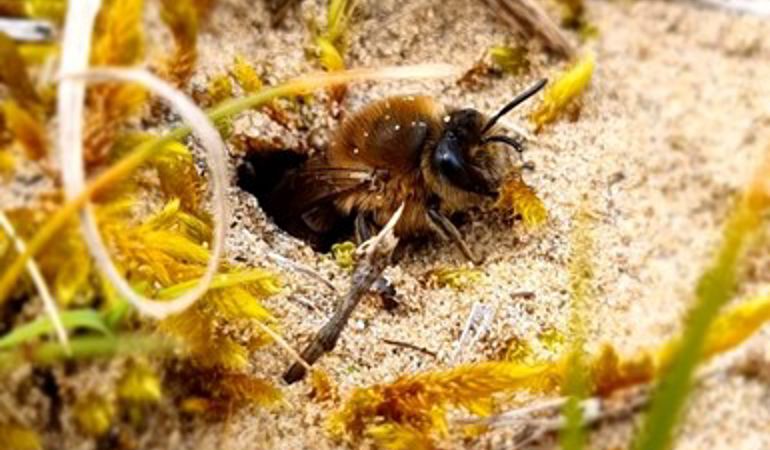Important dune systems come alive with wildlife as summer approaches

As summer approaches, Graham Williams, a member of Natural Resources Wales’ Land Management Team at Newborough National Nature Reserve and Forest writes about the site’s biodiversity and wildlife, including the vernal mining bee.
To stroll out on one of our coastal dune systems on a warm afternoon in spring is to witness the awakening of the dune inhabitants from their long winter slumber.
The first flowers to emerge, such as the yellow blossoms of coltsfoot, amongst the marram and dandelion on the green rolling canvass of fixed dunes and slacks are an early indicator of the succession of diverse species that will eventually carpet the dunes by mid-summer.
Tending to these flowers and ensuring their pollination is an army of invertebrates that go about their business largely unseen, but without which life on earth itself would be in peril. It really is a case of the small things matter.
Sand dunes support some of the richest invertebrate assemblages in the UK on a highly specialised and threatened habitat that can by definition only occur in limited areas of our coast. Many of the invertebrates on our dunes are therefore rare and wholly dependent on a rich mosaic of fixed and dynamic dune habitats.
Some of our key species on dry dune areas are aculeates, a family of insects that contains ants, bees and wasps. These species thrive on the warm areas of exposed or partially exposed sand, often living a solitary existence. However, not all are solitary. On calm sunny days from late March to early June you might be lucky to see large numbers of vernal mining bees flying about or emerging from their collective burrows or nest aggregations.
The vernal mining bee is found throughout central and northern Europe extending east to China and Mongolia. Its mass emergence is synchronised with the appearance of male willow catkins, with male bees emerging before females.
The bees nest in firm, bare or sparsely-vegetated sandy slopes or hummocks, usually south facing, sometimes in very dense aggregations. Each nest has a main perpendicular burrow with short, alternate and radially-arranged lateral branches in the deepest part of the burrow, each terminating in a single cell.
A typical nest contains five or six cells each containing a single egg and a pollen mass. In hard sand, the main burrow is 12cm deep but in loose sand it may extend between 28 to 80cm. Each cell is lined with a transparent cellophane-like membrane which is waterproof, resistant to fungal attack and maintains the correct humidity level during larval development. The source of the membrane is a liquid secretion of the Dufour's gland in the abdomen which is applied with the tongue.
Until very recently, the vernal mining bee had a very restricted distribution in the UK with populations confined to coastal dune systems in Wales and north-west England. It has been recognised as a distinct subspecies, from continental populations on the basis of certain morphological and biological features.
In Wales, it has historically been found on many of our major dune systems such as Newborough, where colonies can number in the thousands. In good years, almost all suitable nesting habitat can be occupied. Whilst mostly restricted to the large coastal dune systems it has now spread to both active and disused sand quarries inland and smaller dune systems such as Morfa Conwy and Cinmel.
Whilst its recent spread to areas outside of its core habitat strongholds is a success story, the direct loss of dune habitat by conversion to other land uses and the decline in bare and open sand dune habitat has impacted the species over the past few decades.
Bare sand is the lifeblood of our dune systems, but our larger sites now support as little as 3 per cent of this precious resource with sites like Newborough having lost much of its bare sand habitat since the 1940s.
Management of our core dune areas through controlling impacts that drive stabilisation and restoring precious dune habitat is key to ensuring the survival of our specialist invertebrates and wider dune biodiversity.
